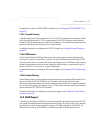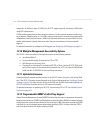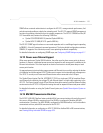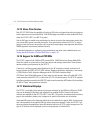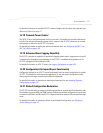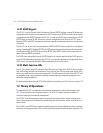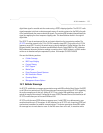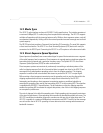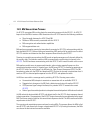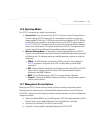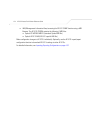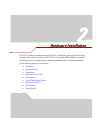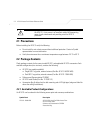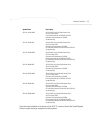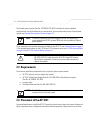
AP-5131 Introduction
1-21
1.3.3 Media Types
The AP-5131 radio interface conforms to IEEE 802.11a/b/g specifications. The interface operates at
a maximum 54Mbps (802.11a radio) using direct-sequence radio technology. The AP-5131 supports
multiple-cell operations with fast roaming between cells. Within a direct-sequence system, each cell
can operates independently. Adding cells to the network provides increased coverage area and total
system capacity.
The RS-232 serial port provides a Command Line Interface (CLI) connection. The serial link supports
a direct serial connection. The AP-5131 is a Data Terminal Equipment (DTE) device with male pin
connectors for the RS-232 port. Connecting the AP-5131 to a PC requires a null modem serial cable.
1.3.4 Direct-Sequence Spread Spectrum
Spread spectrum (broadband) uses a narrowband signal to spread the transmission over a segment
of the radio frequency band or spectrum. Direct-sequence is a spread spectrum technique where the
transmitted signal is spread over a particular frequency range. The Symbol AP-5131 uses Direct-
Sequence Spread Spectrum (DSSS) for radio communication.
Direct-sequence systems communicate by continuously transmitting a redundant pattern of bits
called a chipping sequence. Each bit of transmitted data is mapped into chips by the AP-5131 and
rearranged into a pseudorandom spreading code to form the chipping sequence. The chipping
sequence is combined with a transmitted data stream to produce the AP -5131’s output signal.
MUs receiving a direct-sequence transmission use the spreading code to map the chips within the
chipping sequence back into bits to recreate the original data transmitted by the AP-5131.
Intercepting and decoding a direct-sequence transmission requires a predefined algorithm to
associate the spreading code used by the transmitting AP-5131 to the receiving MU. This algorithm
is established by IEEE 802.11b specifications. The bit redundancy within the chipping sequence
enables the receiving MU to recreate the original data pattern, even if bits in the chipping sequence
are corrupted by interference.
The ratio of chips per bit is called the spreading ratio. A high spreading ratio increases the resistance
of the signal to interference. A low spreading ratio increases the bandwidth available to the user. The
AP-5131 uses different modulation schemes to encode more bits per chip at higher data rates. The
AP-5131 is capable of a maximum 54Mbps data transmission rate (802.11a radio), but the coverage
area is less than that of AP-5131 operating at lower data rates since coverage area decreases as
bandwidth increases.



